Troubleshooting Unable to Run .exe Files on Windows
Running .EXE files can sometimes be troublesome for Windows users, even when using the latest Windows version. This situation is often manifested in errors such as Access Denied, Runtime Error... So, what are the causes and how can they be resolved?
Reasons for .exe files not running
Although the Windows operating system has gradually improved to perform smoother, it certainly does not avoid errors that still occasionally occur. Errors like not being able to open EXE files on your PC are part of those errors. And, like most errors, issues with EXE files can arise due to many different problems. Here are a few of those reasons:
- Malware: Malware has caused all sorts of problems on Windows from time immemorial and is very likely to continue in the future. Thus, in some cases, your EXE files might have been infected with malware, causing issues when opening them.
- Group Policy issues: Group Policy is a largely unknown feature in Windows but nonetheless an indispensable feature. It allows you to control and manage the operating system, applications, and user settings within your Active Directory environment.
- Incorrect file associations: Sometimes, applications are associated with nonsensical links. Therefore, if a file is mistakenly associated in the EXE format, it will not work.
- File system issues: If there are some underlying issues with your file system, then the necessary files to run EXE files will not work.
Ways to fix issues with .exe files not running or opening
1. Restart PC
The simplest solutions are usually the most overlooked. One of them is restarting Windows. Because a simple restart clears the memory occupied by various applications, it can resolve a series of issues that may continue to trouble your PC.
2. Scan your computer for viruses
If the .exe file you downloaded is intact, not corrupted during the download but cannot be opened, and this is happening with many files and not just one, and moreover, the icon of the .exe file looks corrupted and is the same for every .exe file, then think immediately of viruses, malware. If you can still run antivirus software, perform a full scan (Full scan). Scanning for viruses may only eliminate the malware on your computer and cannot restore the files they have damaged.
Therefore, after scanning, you will have to reinstall the software. To prevent this from happening again, install antivirus software on your machine right away, at least turn on Windows Defender.
3. Edit file association settings
If some of your files are affected by incorrect file links, then fixing them might help your EXE files open and operate normally again. Don't panic because of the seemingly complicated solution name - it's a quite simple process. Here is how you can edit file association settings:
- Right-click on the executable file and select Open with > Choose another app.
- Click on More apps and check the box Always use this app to open EXE files.
- Then select Windows Command Processor or Windows Explorer as the default application.
4. Download the exe file fix (recommended)
Many of you reported issues with not being able to open any .exe file after editing the registry. Perhaps there was an error in the process somewhere, even missing a single mark can lead to problems. Therefore, the easiest way for you to fix the inability to open/run .exe files is to download this file.
Unzip, right-click on the unzipped file, select Install to install. This file was created by BKAV, it not only helps fix the error of opening .exe files but also helps fix the entire shortcuts Regedit, Task Manager, Folder Options...
5. Restore the Program files folder to the default location
The issue of not being able to open .exe files might be because you have inadvertently changed the location of the Program files folder. Try restoring this folder to its default location to see if the error can be fixed.
Step 1: Open Registry Editor using the regedit command in the Run window.
Step 2: The Registry Editor interface appears, navigate through the following path:
HKEY_LOCAL_MACHINE\SOFTWARE\Microsoft\Windows\CurrentVersion
Step 3: In CurrentVersion, find the entry named ProgramFilesDir on the right pane and double-click on it.
Step 4: In the window that appears, change the value in the Value Data box to C:\Program Files and click OK.
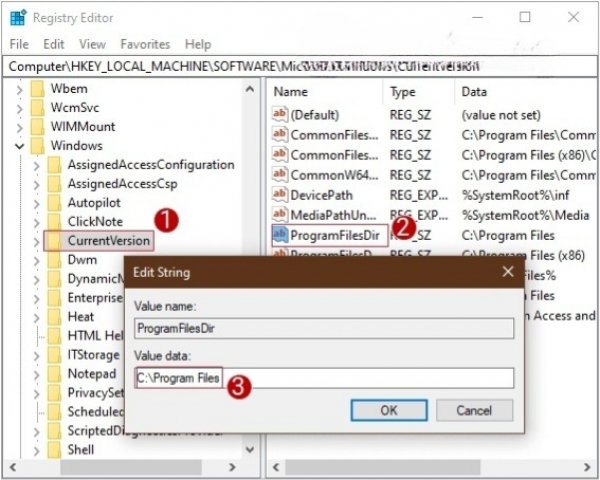
Step 5: For users with 64-bit computers only. Move to ProgramFilesDir (x86) in the same section, change the value in the Value Data box to C:\Program Files (x86) and OK to save changes.
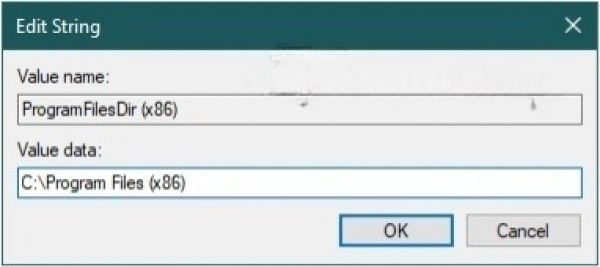
Step 6: Close the Registry Editor and restart the computer.
6. Rename the .exe file
As mentioned before, malware and rootkits may block security programs from launching, so when downloading these tools, you need to rename them before saving to the desktop.
Note: Renaming the file after it has been downloaded will not be effective as it can be detected and prevented from renaming immediately, and even block the downloading of that file.
If you want to copy software from a USB to a computer infected with a virus, remember to rename the software before plugging the USB into the machine.
In most cases, ComboFix only needs to be renamed temporarily. However, for some programs like advanced "Antivirus" malware, trojans (for example, 'Windows Police Pro'), you will need to rename ComboFix to CF.bat before saving this file to your desktop. Ensure that the selection at 'Save as Type:' is "All Files."
Additionally, with MalwareBytes, you need to rename the file twice:
- Before downloading the file or before saving it to your computer.
- After installing, go to the program's installation folder, find mbam.exe, and rename it.
You can also check for the presence of the TDSS driver as follows:
- Go to Control Panel.
- Select System > Hardware > Device Manager.
- In the View menu select "Show Hidden Devices".
- Click on "Non Plug and Play Drivers" to expand.
- Right-click on TDSSserv.sys (if present) and select Properties > Driver, click stop to disable it.
- If asked to restart the computer, choose No.
Additionally, disable other variants if seen such as: seneka*, gao*, UAC*, geyek*, ytasfw*… these are variants of rootkit developed over time.
Some variants of antivirus programs (such as SystemSecurity) named as random numbers running from the Application Data folder (like 4283411.exe or 3251452.exe) will monitor every program you try to download. When you try to open or run, they will be flagged as infected, and also block all executable files, except for important system files.
To bypass being blocked, you can download the Process Explorer utility and rename it to svchost.exe or winlogon.exe (like the name of important system files) and launch it. Then you can locate SystemSecurity to find and terminate the processes named random numbers. You can run Malwarebytes or ComboFix right after that.
7. Download a fix for unable to open *.exe files
a. Use Fix it
To fix this error, you can download and install Fix it on your machine. After downloading Fix it, the next step is to install it. Click on the file you just downloaded, then a File Download dialog box appears on the screen, click Run and follow the on-screen instructions.
b. Use RstAssociations
- Download and run RstAssociations (.scr version).
- Check Exe then click Restore.
- Restart your computer if required.
Note: RstAssociations is compatible only on Windows XP, Vista, and Windows 7 (32 and 64 bit).
c. Use Exefix_Vista.reg file (for Windows XP only)
- Visit the website: winhelponline.com.
- Download the file to fix the EXE extension error.
- Unzip the file on the Desktop.
- Right-click on the Exefix_Vista.reg file.
- Choose Yes then choose OK.
8. Import a new registry into the computer
Step 1: Open Notepad by entering Notepad in the Search Start Menu box or on the Taskbar and click on the application.
Step 2: Copy and paste the following command line into Notepad:
Windows Registry Editor Version 5.00
[HKEY_CLASSES_ROOT.EXE]
@="exefile"
"Content Type"="application/x-msdownload"
[HKEY_CLASSES_ROOT.EXEPersistentHandler]
@="{098f2470-bae0-11cd-b579-08002b30bfeb}"
[HKEY_CLASSES_ROOTexefile]
@="Application"
"EditFlags"=hex:38,07,00,00
"FriendlyTypeName"=hex(2):40,00,25,00,53,00,79,00,73,00,74,00,65,00,6d,00,52,
00,6f,00,6f,00,74,00,25,00,5c,00,53,00,79,00,73,00,74,00,65,00,6d,00,33,00,
32,00,5c,00,73,00,68,00,65,00,6c,00,6c,00,33,00,32,00,2e,00,64,00,6c,00,6c,
00,2c,00,2d,00,31,00,30,00,31,00,35,00,36,00,00,00
[HKEY_CLASSES_ROOTexefileDefaultIcon]
@="%1"
[HKEY_CLASSES_ROOTexefileshell]
[HKEY_CLASSES_ROOTexefileshellopen]
"EditFlags"=hex:00,00,00,00
[HKEY_CLASSES_ROOTexefileshellopencommand]
@=""%1" %*"
"IsolatedCommand"=""%1" %*"
[HKEY_CLASSES_ROOTexefileshellrunas]
[HKEY_CLASSES_ROOTexefileshellrunascommand]
@=""%1" %*"
"IsolatedCommand"=""%1" %*"
[HKEY_CLASSES_ROOTexefileshellex]
[HKEY_CLASSES_ROOTexefileshellexDropHandler]
@="{86C86720-42A0-1069-A2E8-08002B30309D}"
[-HKEY_CURRENT_USERSoftwareMicrosoftWindowsCurrentVersionExplorerFileExts.exeUserChoice]
Step 3: Choose File > Save As.
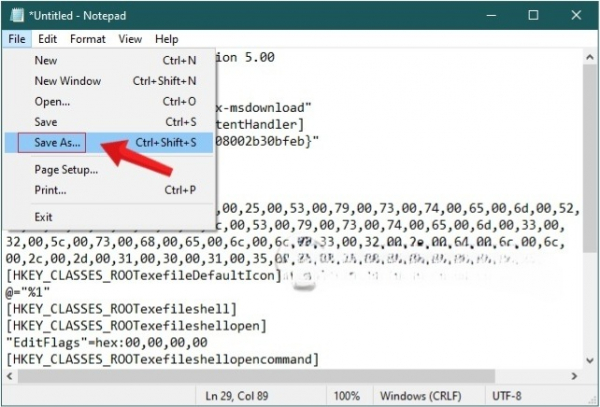
Select the file format as All files. Name the file as Restore.reg, noting the .reg extension, then Save it.
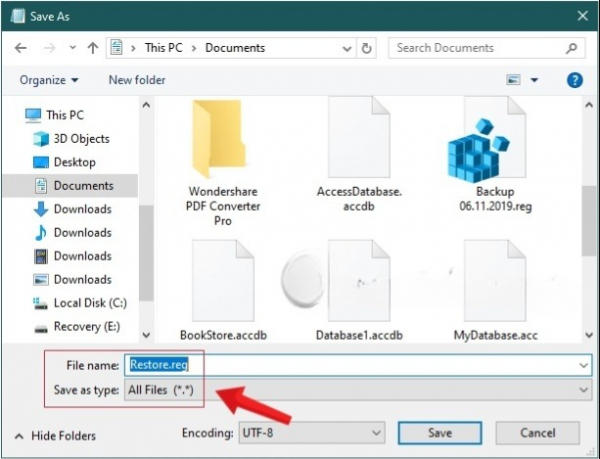
Step 4: Close Notepad then right-click on the .reg file you just saved and choose Merge.
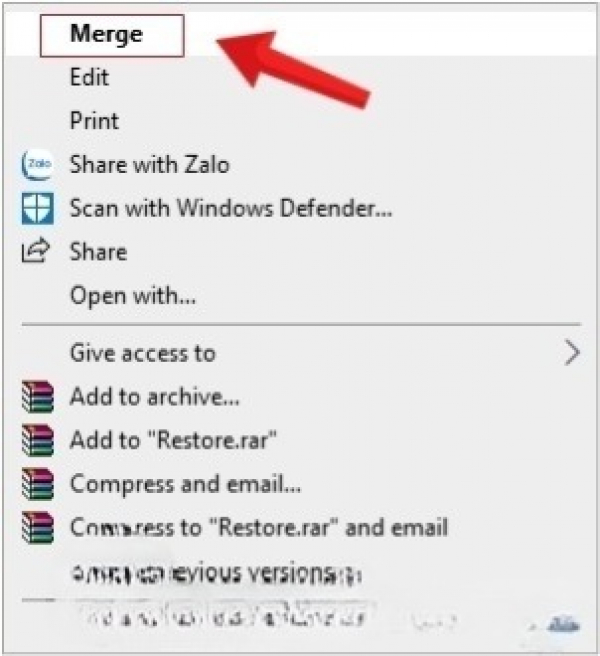
Step 5: Click Yes then click OK. Restart your computer to check results.
9. Edit the Registry to fix exe file running errors
Step 1: Press the Windows+R keys to open the Run command window.
Step 2: Enter the following command and press Enter: regedit
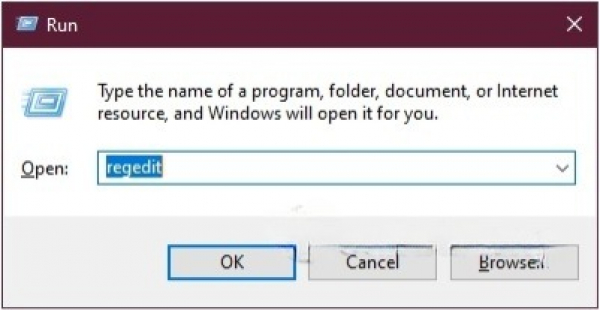
Step 3: In the window that appears, delete the value in the Value Data box and enter exefile, then click OK.

Step 4: Next, navigate following this path:
HKEY_CLASSES_ROOT\exefile\shell\open\command
In command, look to the right to find an entry named Default and double-click on it. Change Value data to:
"%1" %*
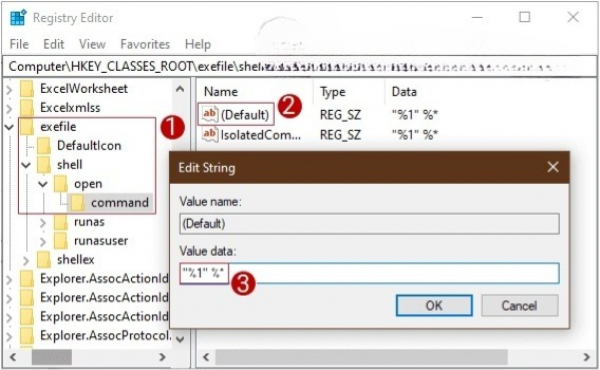
Step 5: Close Registry Editor and restart your computer.
After restarting, try running the .exe file again, check if the problem persists.
10. Check account permissions
Like most operating systems, Windows also uses an account privilege model that allows or limits your access or privileges as a user account. It sets limits on what you can or cannot do with your Windows files.
Therefore, if you are using a guest account with limited access or your computer is administrated by an administrator in an organization, your privileges may be severely restricted.
One way to limit account privileges is to restrict access to certain files or programs. In your case, access to EXE files may have been intentionally restricted by someone. So, if you are in a formal environment or using someone else's PC, ask the PC administrator to grant you access to the EXE files on the computer.
11. Change user accounts
Continuing the viewpoint on accounts and rights above, the article advises you to change your user account. Due to simple limits and restrictions related to rights, often you might not be able to perform certain actions. In such cases, simply switching user accounts can solve many problems.
Click on the search bar in the Start menu and right-click on Sign-out. Now, wait a few minutes until you successfully log out of the PC and return to the login screen.
From there, click on the new user account, log in and then try running your EXE file again.
Encountering the error message “Can't open this type of file” can certainly be frustrating. However, try the methods above and you will have a good chance of permanently escaping this error. The article provides some ways to help you fix the error of not being able to open or run *.exe files on your computer, hoping it can be helpful. In case the error still exists, the article advises you to restore comprehensive factory settings as a last resort.
